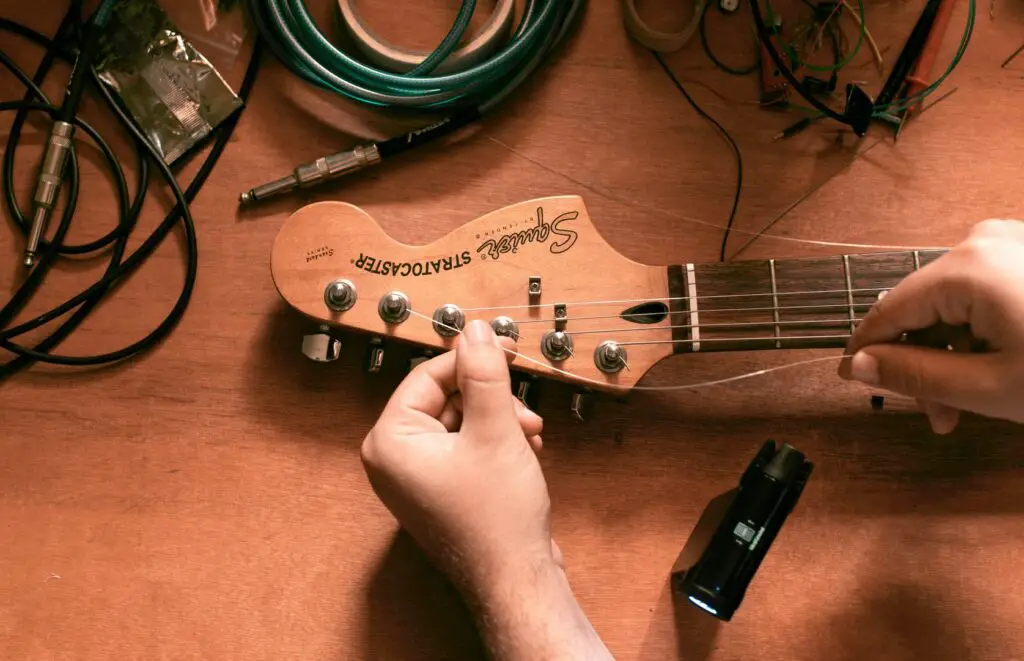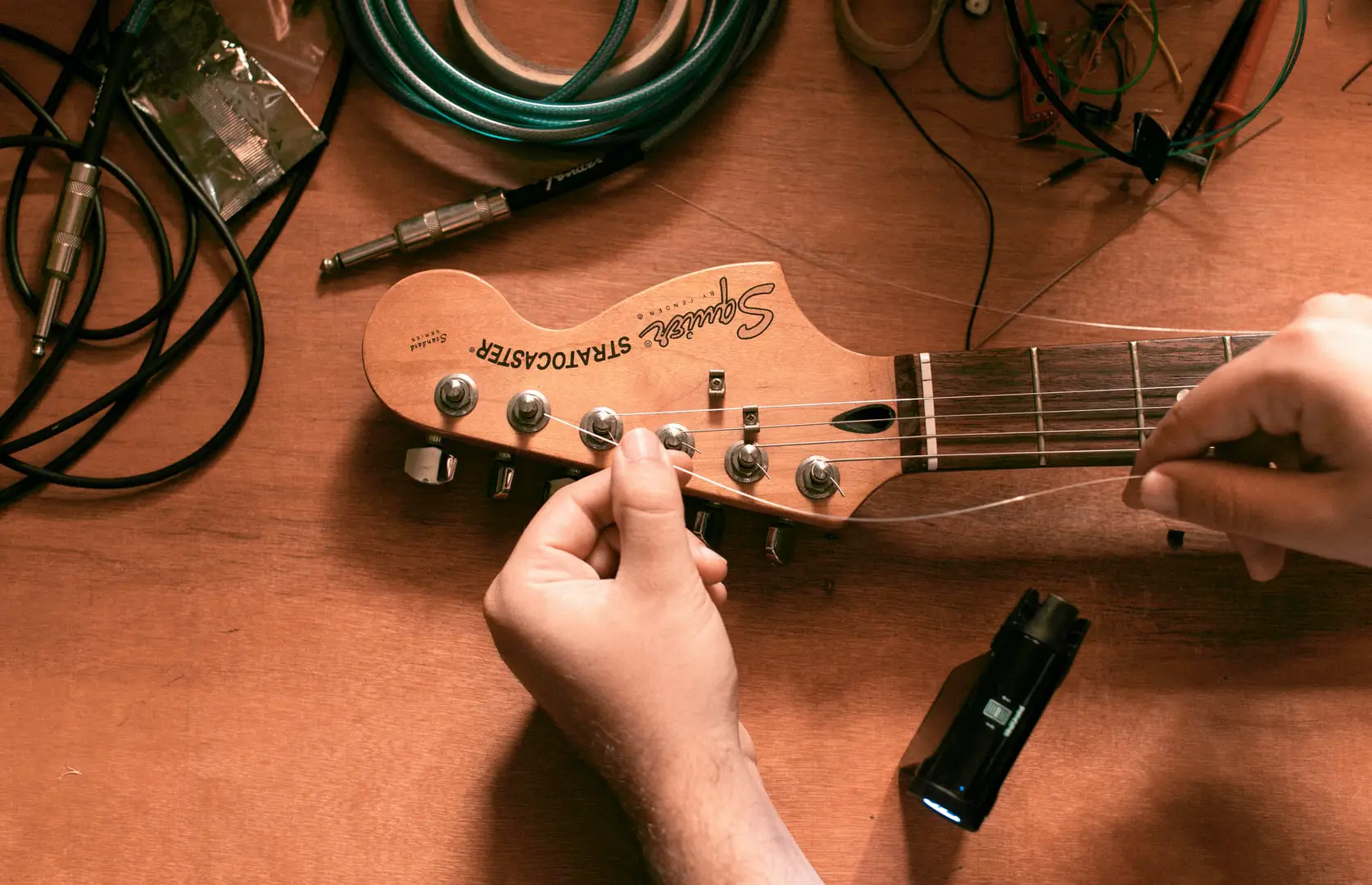In this article we will be looking in depth at the string tree.
- The problem with non-angled headstocks
- Why use a string tree?
- When should you consider using or replacing string trees?
- Types of String Trees
- How to replace or install string trees
1. The problem with non-angled headstocks
When it comes to headstocks, you may notice that there are angled (like Les Paul, or Gibson) and non-angled (also called straight or flat) ones. Flat headstocks are great. They are easy to be mass-produced, more economical, aesthetically pleasing, and unlikely to break frequently. They are used on the iconic Fender’s Stratocaster and Telecaster designs. However, there are few drawbacks to this design. Since it is non-angled, the higher string tuners are pretty far away from the nut. The shallow break between the nut and the strings, therefore, affects the tuning, stability, and sustain. When strongly bent, the high strings on a straight headstock may pop out of the nut slot because of the narrow-angle behind the nut.
To address these problems, Fender has come up with two solutions: staggered-height tuners and string trees.
You can increase the break angle for those high strings with staggered-height tuners by making the height of the tuner shorter as they move along with the headstock. It’s real progress. However, the question here is about geometry. No matter how much the height of those tuners drops, the angle isn’t going to be as steep as you expect.
2. So, why string trees?
The string tree is the quickest, easiest, and cheapest mod for your guitar.
Although string trees usually aren’t a big concern when you’re looking for a guitar or bass guitar, they do play a significant role in helping your instrument sound right. As pointed out above, Fender’s traditional flat headstock and inline tuners make those first strings farther from the nut, making the break angle shallow. Improving this angle is a must. Installing a string tree is a quick and efficient solution. They can be small but will have a significant impact on your tuning.

Not all guitars need a string tree. Used or not depends on the design and structure of the headstock. Only guitars that do not have the headstock tilted back to create a proper bend over the neck should be used. Let’s look at some examples below. Gibson’s head is tilted back an angle from the neck, and this angle creates enough downward pressure to keep the strings firmly in their slots across the nut to tuners. By contrast, strats, teles, and most guitar tuners contain six tuners on a single row, with a straight headstock, parallel to the fretboard.
3. So what exactly can a string tree do?
Located on the guitar’s headstock, it helps provide the tension as the strings go from the nut to tuners. People usually put one between the first two strings (B&E) or sometimes add another one between the 3rd and 4th strings (D&G). In short, they increase the angle of breakage of the strings, i.e. the angle that the string creates when it bends over from the nut to the tuners. It keeps the strings from coming out of the nut. The pressure boost also makes the sound sustain longer when the string is played in the open position.
4. When should you consider using, or replacing string trees?
Most of the Fender-style stratocasters and telecasters are equipped with string trees or staggered-tuners. If there is already a string tree, go with it. If it has staggered-height tuners, but somehow you still feel like the tuning is wrong, you can try installing a string tree between the E and B strings. The number of string trees depends on your own experience.
There are also some cases that you want to replace the original string trees:
- Improve the quality: usually, original string trees are cheap metal “butterfly” string trees which create friction between the strings and the retainers. In this case, upgrading your guitar by replacing the string trees is the right choice.
- Enhance the look: these days, string trees come in various designs, colors, etc. You can easily find many options at your local store, or on e-commerce sites.
- Broken or worn out: obviously, you have to replace your retainers in this case. If you can’t repair by yourself, look for a luthier, or any expert you trust.
In rare cases, you might think of removing the current string trees. Our advice is to think twice before doing this. If tuning is stable, just let it be. Trying to remove trees may lead to the strings buzzing in the nut when played openly. Those strings are designed to make your strings stay in tune better, though. Also, removing the tree will leave a hole on your headstock, which is not aesthetically pleasing at all.
5. How to replace, or install string trees?
For guitars that haven’t got string trees, to begin with, you’ll need to use a drill to create new holes in the headstock. Make sure the hole is centered between the two strings when you are installing them. If you choose to drill, be careful not to damage the headstock. You can get a luthier to do this for you if you are not familiar with this.
This installation for these string trees can be done in only a few minutes. You don’t need to remove your old strings altogether so that you can save yourself some money. You can, however, choose to replace the strings at this time, since it makes it a little easier to do the installation.
So, let’s start!
First, you need to prepare:
- A small Phillips screwdriver
- A bit of soap or wax to smoothly lubricate while screwing
Steps:
- Loosen the strings: We need to remove all the tension from the strings, but don’t let them unwind from the tuning pegs. If this happens, you will have trouble putting them back on, and you will need to replace them.
- Remove the old ones with a screwdriver: When the strings are loose, remove the old string trees with the screwdriver. Don’t throw them away in case you plan to restore the guitar to its original state, which is unlikely to happen anyway.
- Drill the new string tree into the hole: Now that the old string trees have been replaced, we’ll have the new ones installed. Partially screw the new string trees into the holes. They’re supposed to go in without too much effort. If you’re struggling to screw in the holes, you might need to drill to widen it. Remember to hold the string tree parallel to the string.
- Screw the string trees: Screw in the string trees until they’re tight but can still be rotated slightly.
- Tighten up the strings a little bit: We want enough tension on them to get them in the correct position, not to damage them before we finish tightening.
- Place the string in the groove of the string trees: Turn the string tree slightly if necessary to make sure there is as little resistance as possible to the string.
- Once the string tree is lined up, finish tightening the screws. Don’t turn the screw too tight; otherwise, you could strip the hole and need to start over again.
Depending on your guitar, you should notice an immediate increase in tuning stability. Combined with proper nuts and locking tuners, you’ll have rock-solid tuning under just about any situation.
Conclusion
To sum up, using string trees is a great way to improve your guitar’s tuning, stability, and sustain. If you have staggered tuners, you probably won’t need string trees. But in case of experiencing any wrong tuning, give it a try. It’s the most economical mod to upgrade your guitar without having to purchase another guitar.

